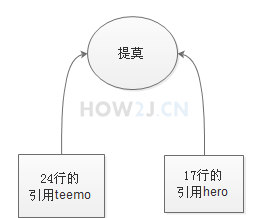2018-03-14
一、this这个关键字,相当于普通话里的“我” ,例如:
小明说 “我吃了” 这个时候,“我” 代表小明
小红说 “我吃了” 这个时候,“我” 代表小红
"我"代表当前人物 。
1、this即代表当前对象:
public class Hero { String name; //姓名 float hp; //血量 float armor; //护甲 int moveSpeed; //移动速度 //打印内存中的虚拟地址 public void showAddressInMemory(){ System.out.println("打印this看到的虚拟地址:"+this); } public static void main(String[] args) { Hero garen = new Hero(); garen.name = "盖伦"; //直接打印对象,会显示该对象在内存中的虚拟地址 //格式:Hero@c17164 c17164即虚拟地址,每次执行,得到的地址不一定一样 System.out.println("打印对象看到的虚拟地址:"+garen); //调用showAddressInMemory,打印该对象的this,显示相同的虚拟地址 garen.showAddressInMemory(); Hero teemo = new Hero(); teemo.name = "提莫"; System.out.println("打印对象看到的虚拟地址:"+teemo); teemo.showAddressInMemory(); } }
2、通过this关键字访问对象的属性:
public class Hero { String name; //姓名 float hp; //血量 float armor; //护甲 int moveSpeed; //移动速度 //参数名和属性名一样 //在方法体中,只能访问到参数name public void setName1(String name){ name = name; } //为了避免setName1中的问题,参数名不得不使用其他变量名 public void setName2(String heroName){ name = heroName; } //通过this访问属性 public void setName3(String name){ //name代表的是参数name //this.name代表的是属性name this.name = name; } public static void main(String[] args) { Hero h =new Hero(); h.setName1("teemo"); System.out.println(h.name); h.setName2("garen"); System.out.println(h.name); h.setName3("死歌"); System.out.println(h.name); } }
3、通过this调用其他的构造方法:
如果要在一个构造方法中,调用另一个构造方法,可以使用this()
public class Hero { String name; //姓名 float hp; //血量 float armor; //护甲 int moveSpeed; //移动速度 //带一个参数的构造方法 public Hero(String name){ System.out.println("一个参数的构造方法"); this.name = name; } //带两个参数的构造方法 public Hero(String name,float hp){ this(name); System.out.println("两个参数的构造方法"); this.hp = hp; } public static void main(String[] args) { Hero teemo = new Hero("提莫",383); System.out.println(teemo.name); } }
二、变量有两种类型:基本类型和类类型;参数也是变量,所以传参分为基本类型传参和类类型传参:
1、基本类型传参:
在方法内,无法修改方法外的基本类型参数
public class Hero { String name; //姓名 float hp; //血量 float armor; //护甲 int moveSpeed; //移动速度 public Hero(){} //回血 public void huixue(int xp){ hp = hp + xp; //回血完毕后,血瓶=0 xp=0; } public Hero(String name,float hp){ this.name = name; this.hp = hp; } public static void main(String[] args) { Hero teemo = new Hero("提莫",383); //血瓶,其值是100 int xueping = 100; //提莫通过这个血瓶回血 teemo.huixue(xueping); System.out.println(xueping); } }
2、引用与=
如果一个变量是基本类型,比如 int hp = 50;我们就直接管hp叫变量,=表示赋值的意思。
如果一个变量是类类型,比如 Hero h = new Hero();我们就管h叫做引用。
=不再是赋值的意思,=表示指向的意思:
比如 Hero h = new Hero();这句话的意思是:引用h,指向一个Hero对象。
3、类类型传参:
类类型又叫引用
第24行的引用 teemo与 第17行的引用hero,是不同的引用
通过调用garen.attack(teemo, 100); 使得这两个引用都指向了同一个对象
所以在第18行hero.hp = hero.hp - damage; 就使得该对象的hp值,发生了变化
因此第25行,打印该对象的Hp值就是变化后的值

public class Hero { String name; // 姓名 float hp; // 血量 float armor; // 护甲 int moveSpeed; // 移动速度 public Hero(String name, float hp) { this.name = name; this.hp = hp;
} // 攻击一个英雄,并让他掉damage点血 public void attack(Hero hero, int damage) { hero.hp = hero.hp - damage; } public static void main(String[] args) { Hero teemo = new Hero("提莫", 383); Hero garen = new Hero("盖伦", 616); garen.attack(teemo, 100); System.out.println(teemo.hp); } }